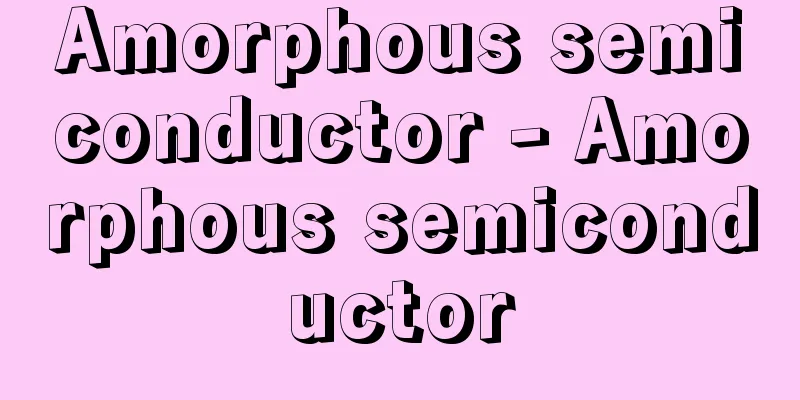Amorphous semiconductor - Amorphous semiconductor

|
A semiconductor that does not have a regular arrangement of atoms. It is also called an amorphous semiconductor. In general, solid crystals can be classified into so-called metals, which have low electrical resistance at room temperature and the resistance increases as the temperature rises, and so-called insulators or semiconductors, which have relatively high electrical resistance at room temperature and the resistance decreases as the temperature rises (however, the electrical resistance of semiconductors at room temperature is intermediate between that of metals and insulators). Semiconductors that do not have crystallinity are collectively called amorphous semiconductors. The main types of amorphous semiconductors are chalcogenide-based semiconductors that contain Group 16 elements such as selenium and tellurium as their main components, and tetrahedral-based semiconductors that contain Group 4 elements such as germanium and silicon as their main components. Because amorphous semiconductors do not have a fixed crystal structure, they can be deposited in the form of a thin film onto a large substrate using thin-film formation techniques such as vacuum deposition, radio-frequency sputtering, and chemical vapor deposition. [Eiichi Maruyama] ApplicationsThe use of amorphous semiconductors began in the 1950s with the development of electrophotographic photosensitive films and photoconductive films for camera tubes using selenium. Electrophotography in particular has made great strides as a core technology in the copying machine industry. Chalcogenide-based amorphous semiconductors have been used in optical disks as reversible optical memory materials. In 1975, tetrahedral hydrogenated amorphous silicon, which allows pn control, attracted attention as a new semiconductor material, and since then, research into practical applications has progressed, leading to its widespread use as a photosensitive material for optical sensors and electrophotography, as well as thin-film solar cells and thin-film transistor (TFT) materials. In particular, amorphous silicon TFTs, along with low-temperature polycrystalline TFTs, occupy a huge market as display elements for LCD TVs, mobile phones, digital cameras, and other devices. [Eiichi Maruyama] [Reference] | | |Amorphous materials do not have a regular arrangement of atoms. However, the distance between atoms is the same as in crystalline structures . Amorphous atomic arrangement model ©Shogakukan "> Structural model of crystalline silicon ©Shogakukan "> Structure of integrated amorphous silicon solar cells… ©Shogakukan "> Optical absorption of hydrogenated amorphous and crystalline silicon… Source: Shogakukan Encyclopedia Nipponica About Encyclopedia Nipponica Information | Legend |
|
規則正しい原子配列をもたない半導体。非晶質半導体ともいう。一般に固体結晶は、常温で低い電気抵抗をもち温度上昇とともに抵抗が上がる、いわゆる金属と、常温で比較的高い電気抵抗をもち温度上昇とともに抵抗が下がる、いわゆる絶縁物または半導体とに分類できる(ただし、半導体は常温での電気抵抗は金属と絶縁物の中間に位置する)。結晶性をもたない半導体を総称してアモルファス半導体とよぶ。おもなアモルファス半導体には、セレン、テルルなど16族元素を主要成分として含むカルコゲナイド系のものと、ゲルマニウム、シリコンなど4族元素を主要成分として含むテトラヘドラル系のものがある。 アモルファス半導体は決まった結晶構造をもたないので、真空蒸着法、高周波スパッタ法、化学気相反応法などの薄膜形成技術を用いて、大面積の基板上に薄膜の形で堆積(たいせき)することができる。 [丸山瑛一] 用途アモルファス半導体の利用は、1950年代にセレンを用いた電子写真感光膜や撮像管の光導電膜が開発されたことに始まる。とくに電子写真は複写機産業の基幹技術として大きく発展した。カルコゲナイド系のアモルファス半導体は可逆光メモリ材料として光ディスクに用いられた。1975年にpn制御ができるテトラヘドラル系の水素化アモルファスシリコンが新しい半導体材料として注目され、その後、実用化の研究が進み、光センサー、電子写真などの感光材料や薄膜太陽電池、薄膜トランジスタ(TFT)材料として広く利用されている。とりわけアモルファスシリコンTFTは低温多結晶TFTと並んで液晶テレビや携帯電話、デジタルカメラなどのディスプレー用素子として巨大な市場を占有している。 [丸山瑛一] [参照項目] | | |アモルファスは規則正しい原子配列をもたない。しかし、原子間の距離は結晶構造の場合と同じである©Shogakukan"> アモルファスの原子配列モデル ©Shogakukan"> 結晶シリコンの構造モデル ©Shogakukan"> 集積型アモルファスシリコン太陽電池の構… ©Shogakukan"> 水素化アモルファスと結晶シリコンの光吸… 出典 小学館 日本大百科全書(ニッポニカ)日本大百科全書(ニッポニカ)について 情報 | 凡例 |
<<: Amorphous substance - amorphous substance
>>: Amorphous solid - Amorphous solid
Recommend
Pulsatilla genus
...The Chinese name for the Chinese plant P. chin...
Bronte sisters - Bronte sisters
The three sisters, Charlotte Brontë (1816-55), Emi...
Person-trip survey
A traffic volume survey of people's movements....
Emperor's Theatre
Generally, it means a performance for the Emperor,...
Cavalry, EP - Cavalry
… American education reflects the complex plurali...
Yukinobu Kano
?-? A painter from the Sengoku period. The second...
solo concerto (English spelling)
…The oldest instrumental concerto is the concerto...
Vajrayana (English spelling)
Tantra Buddhism recognizes the female principle o...
Language education - Gengokyoiku (English)
Generally speaking, it refers to mother tongue edu...
Carlucci, J.
…A representative painter of the first generation...
neue Gymnastik (English spelling) neueGymnastik
…In order to reinforce and promote academic physi...
Haemanthus natalensis (English spelling) Haemanthusnatalensis
…[Tora Saburo Kawabata]. … *Some of the terminolo...
Life jacket - life jacket
Also called a life jacket. A vest made of cloth or...
Bonfire - Kagaribi
[1] 〘Noun〙① = Kagari (bonfire)①※Kokin (905-914) Ko...
Altan Khan (Chief of the Khotgoyt Tribe)
...17th century Khotgoit chieftain of northwester...









